Assessment of Non-Point Source Total Phosphorus Pollution from Different Land Use and Soil Types in a Mid-High Latitude Region of China
Abstract
:1. Introduction
2. Materials and Methods
2.1. Study Area
2.2. Data
2.3. Methods
2.3.1. The Phosphorus Model in EcoHAT-P
2.3.2. Phosphorus Modules in EcoHAT
3. Results
3.1. Validation of the EcoHAT-P Model
3.2. Total Phosphorus during the Period
3.3. Total Phosphorus Loads from Different Land Uses
3.4. Total Phosphorus Loads from Different Soil Types
4. Discussion
4.1. Effect of Land Use Changes on Total Phosphorus
4.2. Response of NPS Phosphorus Load with Temperature
4.3. Uncertainty for Agricultural NPS Phosphorus Pollution Control
4.4. Suggestions for Sustainable Agricultural Land Management in the Future
5. Conclusions
Acknowledgments
Author Contributions
Conflicts of Interest
References
- Sims, J.; Edwards, A.; Schoumans, O.; Simard, R. Integrating soil phosphorus testing into environmentally based agricultural management practices. J. Environ. Qual. 2000, 29, 60–71. [Google Scholar] [CrossRef]
- Townsend, A.R.; Porder, S. Agricultural legacies, food production and its environmental consequences. Proc. Natl. Acad. Sci. USA 2012, 109, 5917–5918. [Google Scholar] [CrossRef] [PubMed]
- McDowell, R.; Sharpley, A. The effects of soil carbon on phosphorus and sediment loss from soil trays by overland flow. J. Environ. Qual. 2003, 32, 207–214. [Google Scholar] [CrossRef] [PubMed]
- Sharpley, A. Identifying sites vulnerable to phosphorus loss in agricultural runoff. J. Environ. Qual. 1995, 24, 947–951. [Google Scholar] [CrossRef]
- Sims, J.; Simard, R.; Joern, B. Phosphorus loss in agricultural drainage: Historical perspective and current research. J. Environ. Qual. 1998, 27, 277–293. [Google Scholar] [CrossRef]
- Beasley, D.; Huggins, L.; Monke, A. Answers: A model for watershed planning. Trans. ASAE 1980, 23, 938–944. [Google Scholar] [CrossRef]
- Davison, P.S.; Withers, P.J.; Lord, E.I.; Betson, M.J.; Strömqvist, J. PSYCHIC—A process-based model of phosphorus and sediment mobilisation and delivery within agricultural catchments. Part 1: Model description and parameterisation. J. Hydrol. 2008, 350, 290–302. [Google Scholar] [CrossRef]
- Knisel, W.G. Creams: A Field Scale Model for Chemicals, Runoff, and Erosion from Agricultural Management Systems; Conservation Research Report (USA); Department of Agriculture, Science and Education Administration: Washington, DC, USA, 1980.
- Neitsch, S.L.; Williams, J.; Arnold, J.; Kiniry, J. Soil and Water Assessment Tool Theoretical Documentation Version 2009; Texas Water Resources Institute: College Station, TX, USA, 2011. [Google Scholar]
- Storm, D.; Dillaha, T., III; Mostaghimi, S.; Shanholtz, V. Modeling phosphorus transport in surface runoff. Trans. ASAE 1988, 31, 117–127. [Google Scholar] [CrossRef]
- Williams, J.R. The erosion-productivity impact calculator (epic) model: A case history. Philos. Trans. R. Soc. B Biol. Sci. 1990, 329, 421–428. [Google Scholar] [CrossRef]
- Yuan, Y.; Bingner, R.; Theurer, F.; Rebich, R.; Moore, P. Phosphorus component in annagnps. Trans. ASAE 2005, 48, 2145–2154. [Google Scholar] [CrossRef]
- Ficklin, D.L.; Luo, Y.; Luedeling, E.; Zhang, M. Climate change sensitivity assessment of a highly agricultural watershed using SWAT. J. Hydrol. 2009, 374, 16–29. [Google Scholar] [CrossRef]
- Ouyang, W.; Skidmore, A.K.; Toxopeus, A.G.; Hao, F.H. Long-term vegetation landscape pattern with non-point source nutrient pollution in upper stream of yellow river basin. J. Hydrol. 2010, 389, 373–380. [Google Scholar] [CrossRef]
- Ouyang, W.; Song, K.Y.; Wang, X.L.; Hao, F.H. Non-point source pollution dynamics under long-term agricultural development and relationship with landscape dynamics. Ecol. Indic. 2014, 45, 579–589. [Google Scholar] [CrossRef]
- Saleh, A.; Du, B. Evaluation of SWAT and HSPF within BASINS program for the upper North Bosque River watershed in central Texas. Trans. ASAE 2004, 47, 1039–1049. [Google Scholar]
- Bouraoui, F.; Dillaha, T.A. Answers-2000: Non-point-source nutrient planning model. J. Environ. Eng. 2000, 126, 1045–1055. [Google Scholar] [CrossRef]
- Dong, G.; Yang, S.; Bai, J.; Wang, Z.; Zhang, Y. Open innovation in the Sanjiang plain: A new paradigm for developing agriculture in china. J. Food Agric. Environ. 2013, 11, 1108–1113. [Google Scholar]
- Liu, C.; Yang, S.; Wen, Z.; Wang, X.; Wang, Y.; Li, Q.; Sheng, H. Development of ecohydrological assessment tool and its application. Sci. China Ser. E Technol. Sci. 2009, 52, 1947–1957. [Google Scholar] [CrossRef]
- Wang, X.; Yang, S.; Mannaerts, C.M.; Gao, Y.; Guo, J. Spatially explicit estimation of soil denitrification rates and land use effects in the riparian buffer zone of the large guanting reservoir. Geoderma 2009, 150, 240–252. [Google Scholar] [CrossRef]
- Wang, X.; Mannaerts, C.M.; Yang, S.; Gao, Y.; Zheng, D. Evaluation of soil nitrogen emissions from riparian zones coupling simple process-oriented models with remote sensing data. Sci. Total Environ. 2010, 408, 3310–3318. [Google Scholar] [CrossRef] [PubMed]
- Wang, X.; Wang, Q.; Yang, S.; Zheng, D.; Wu, C.; Mannaerts, C.M. Evaluating nitrogen removal by vegetation uptake using satellite image time series in riparian catchments. Sci. Total Environ. 2011, 409, 2567–2576. [Google Scholar] [CrossRef] [PubMed]
- Yang, S.; Dong, G.; Zheng, D.; Xiao, H.; Gao, Y.; Lang, Y. Coupling xinanjiang model and swat to simulate agricultural non-point source pollution in songtao watershed of Hainan, China. Ecol. Model. 2011, 222, 3701–3717. [Google Scholar] [CrossRef]
- Zhou, Q.; Yang, S.; Zhao, C.; Cai, M.; Lou, H.; Luo, Y.; Hou, L. Development and implementation of a spatial unit non-overlapping water stress index for water scarcity evaluation with a moderate spatial resolution. Ecol. Indic. 2016, 69, 422–433. [Google Scholar] [CrossRef]
- Lou, H.; Yang, S.; Zhao, C.; Zhou, Q.; Bai, J.; Hao, F.; Wu, L. Phosphorus risk in an intensive agricultural area in a mid-high latitude region of china. Catena 2015, 127, 46–55. [Google Scholar] [CrossRef]
- Ouyang, W.; Huang, H.B.; Hao, F.H.; Guo, B.B. Synergistic impacts of land-use change and soil property variation on non-point source nitrogen pollution in a freeze-thaw area. J. Hydrol. 2013, 495, 126–134. [Google Scholar] [CrossRef]
- Ouyang, W.; Huang, H.; Hao, F.; Shan, Y.; Guo, B. Evaluating spatial interaction of soil property with non-point source pollution at watershed scale: The phosphorus indicator in northeast china. Sci. Total Environ. 2012, 432, 412–421. [Google Scholar] [CrossRef] [PubMed]
- China meteorological data net. Available online: http://data.cma.cn/ (accessed on 8 July 2015).
- United States Geological Survey. Available online: http://www.usgs.gov/pubprod/ (accessed on 8 July 2015).
- Cai, M.Y.; Yang, S.T.; Zhao, C.S.; Zeng, H.J.; Zhou, Q.W. Estimation of daily average temperature using multisource spatial data in data sparse regions of central Asia. J. Appl. Remote Sens. 2013, 7. [Google Scholar] [CrossRef]
- Nachtergaele, F. Soil Taxonomy—A Basic System of Soil Classification for Making and Interpreting Soil Surveys: By Soil Survey Staff, 1999, Usda–Nrcs, Agriculture Handbook Number 436, Hardbound; Elsevier: Amsterdam, The Netherlands, 2001. [Google Scholar]
- Cai, M.Y.; Yang, S.T.; Zeng, H.J.; Zhao, C.S.; Wang, S.D. A distributed hydrological model driven by multi-source spatial data and its application in the Ili river basin of central Asia. Water Resour. Manag. 2014, 28, 2851–2866. [Google Scholar] [CrossRef]
- Singh, V.P. Computer Models of Watershed Hydrology; Water Resources Publications: Highlands Ranch, CO, USA, 1995. [Google Scholar]
- Williams, J.R. Sediment routing for agricultural watersheds 1. J. Am. Water Resour. Assoc. 1975, 11, 965–974. [Google Scholar] [CrossRef]
- Neitsch, S.L.; Arnold, J.G.; Kiniry, J.R.; Williams, J.R. Overview of Soil and Water Assessment Tool (SWAT) Model; Tier B (All Countries/Territories not Listed Here are in Tier A); World Association of Soil and Water Conservation: Ankeny, IA, USA, 2009; Volume 8, p. 3. [Google Scholar]
- Jones, C.A.; Cole, C.V.; Sharpley, A.N.; Williams, J.R. A simplified soil and plant phosphorus model. I. Documentation. Soil Sci. Soc. Am. J. 1984, 48, 800–805. [Google Scholar] [CrossRef]
- Zhu, W.Q.; Pan, Y.Z.; Zhang, J.S. Estimation of net primary productivity of Chinese terrestrial vegetation based on remote sensing. Acta Phytoecol. Sin. 2007, 31, 413–424. [Google Scholar]
- Zhu, Z.X.; Arp, P.A.; Meng, F.R.; Bourque, C.P.A.; Foster, N.W. A forest nutrient cycling and biomass model (fornbm) based on year-round, monthly weather conditions, part 1: Assumption, structure and processing. Ecol. Model. 2003, 169, 347–360. [Google Scholar] [CrossRef]
- Arp, P.A.; Oja, T. A forest soil vegetation atmosphere model (forsva), I: Concepts. Ecol. Model. 1997, 95, 211–224. [Google Scholar] [CrossRef]
- Neitsch, S.; Arnold, J.; Kiniry, J.; Williams, J.; King, K. Soil and Water Assessment Tool Theoretical Documentation; Grassland, Soil and Water Research Laboratory: Temple, TX, USA, 2005. [Google Scholar]
- Ouyang, W.; Shan, Y.; Hao, F.; Chen, S.; Pu, X.; Wang, M.K. The effect on soil nutrients resulting from land use transformations in a freeze-thaw agricultural ecosystem. Soil Tillage Res. 2013, 132, 30–38. [Google Scholar] [CrossRef]
- Ouyang, W.; Xu, Y.; Hao, F.; Wang, X.; Siyang, C.; Lin, C. Effect of long-term agricultural cultivation and land use conversion on soil nutrient contents in the sanjiang plain. Catena 2013, 104, 243–250. [Google Scholar] [CrossRef]
- Yang, W.; Cheng, H.; Hao, F.; Ouyang, W.; Liu, S.; Lin, C. The influence of land-use change on the forms of phosphorus in soil profiles from the sanjiang plain of China. Geoderma 2012, 189, 207–214. [Google Scholar] [CrossRef]

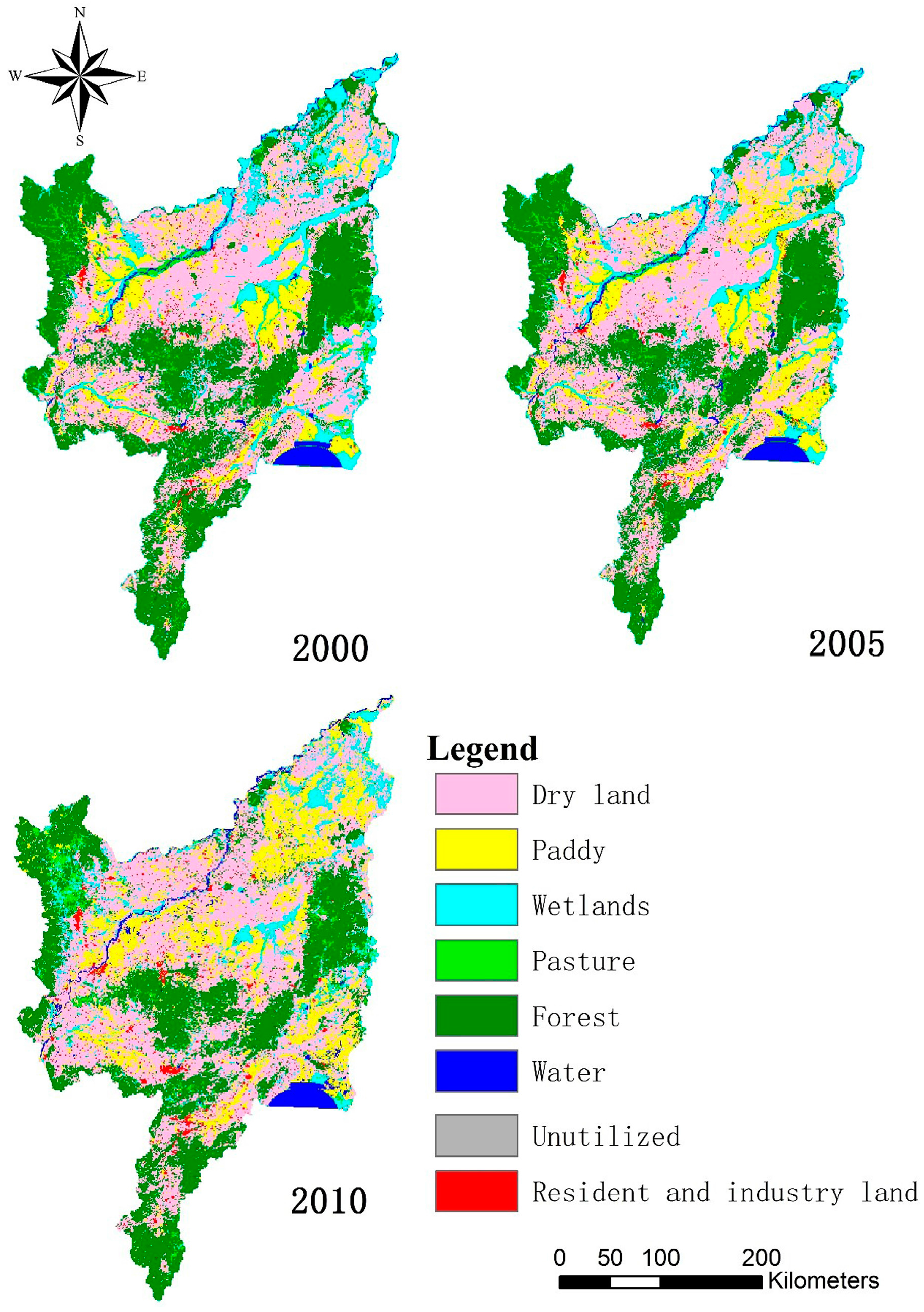
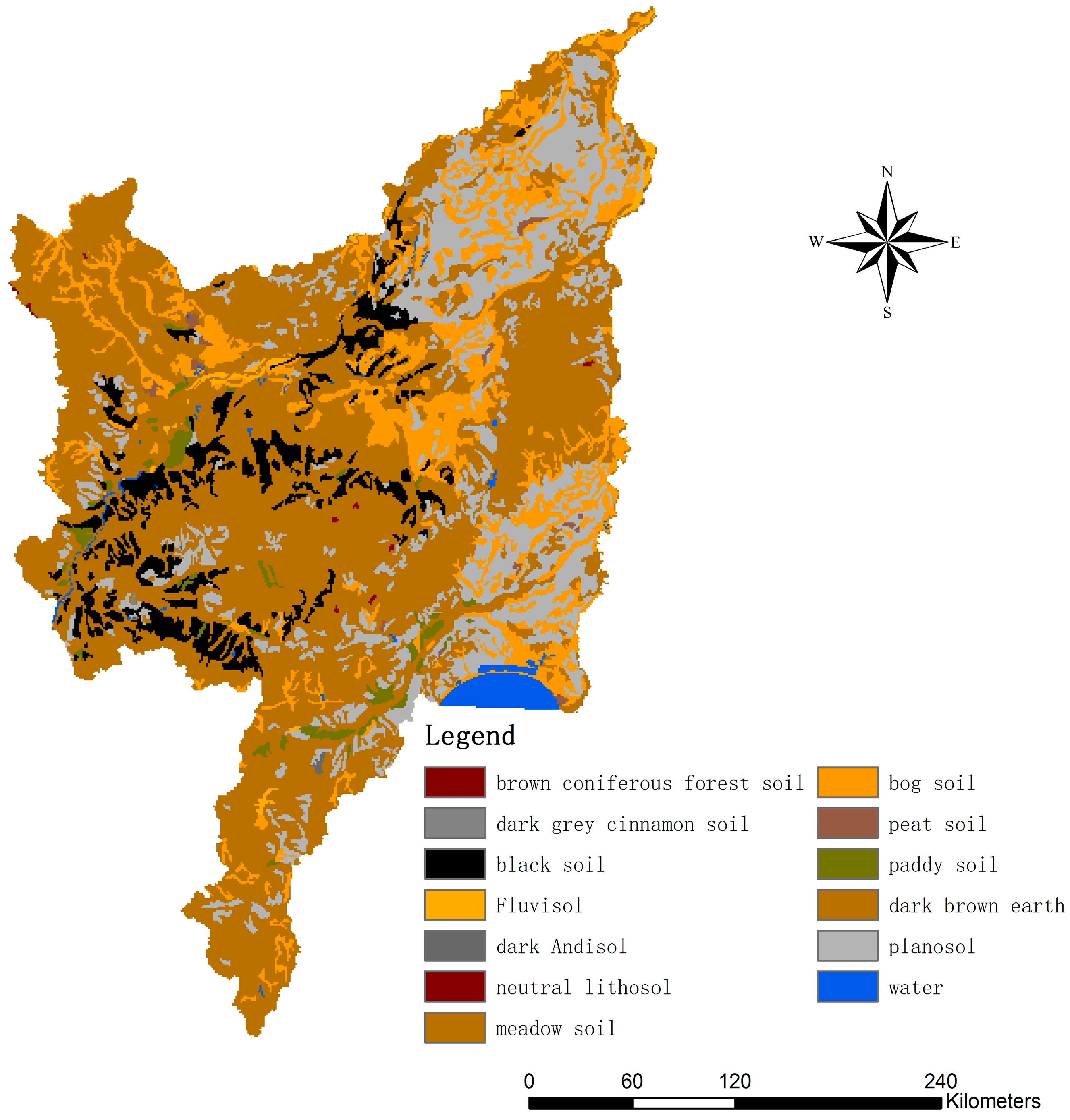
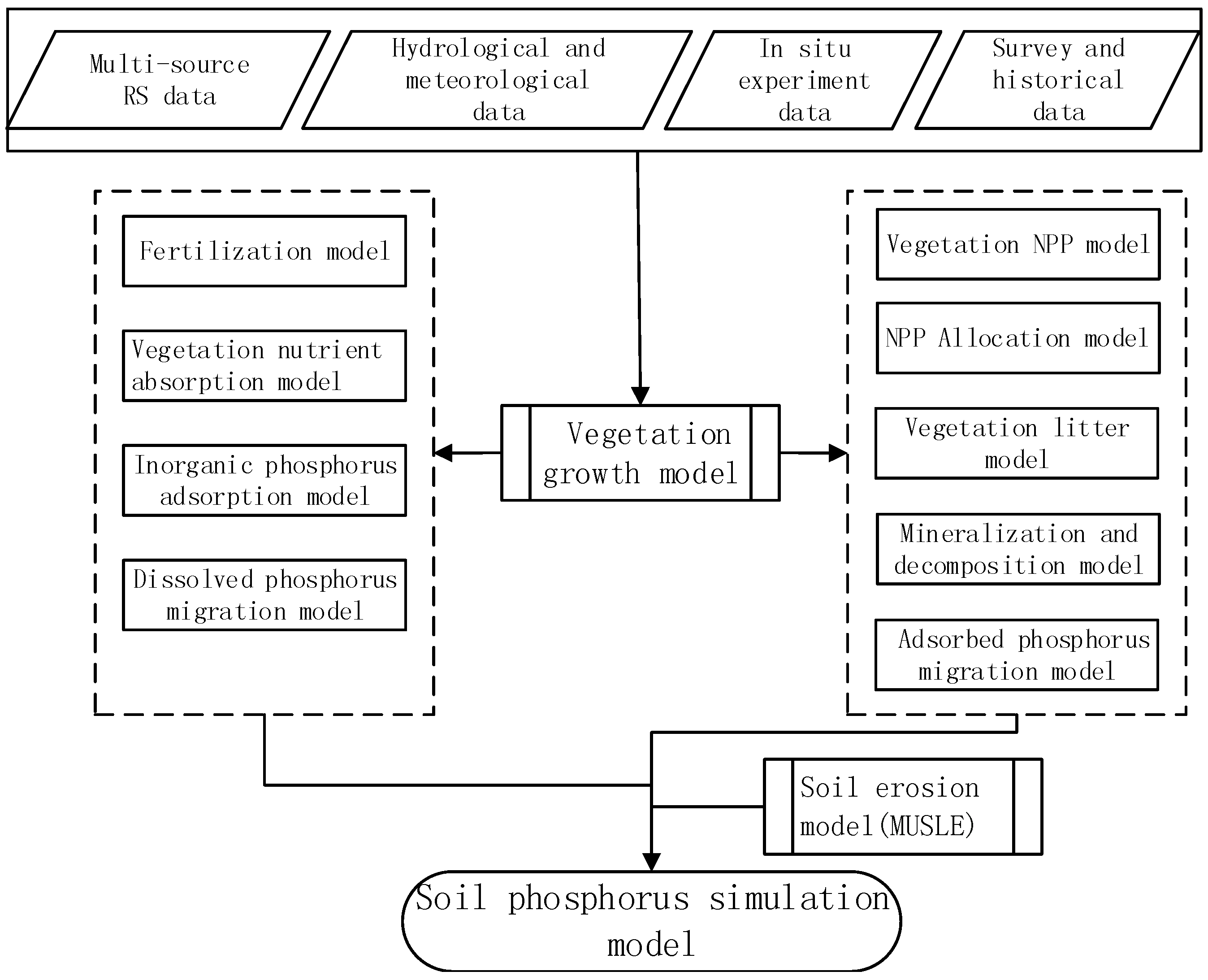

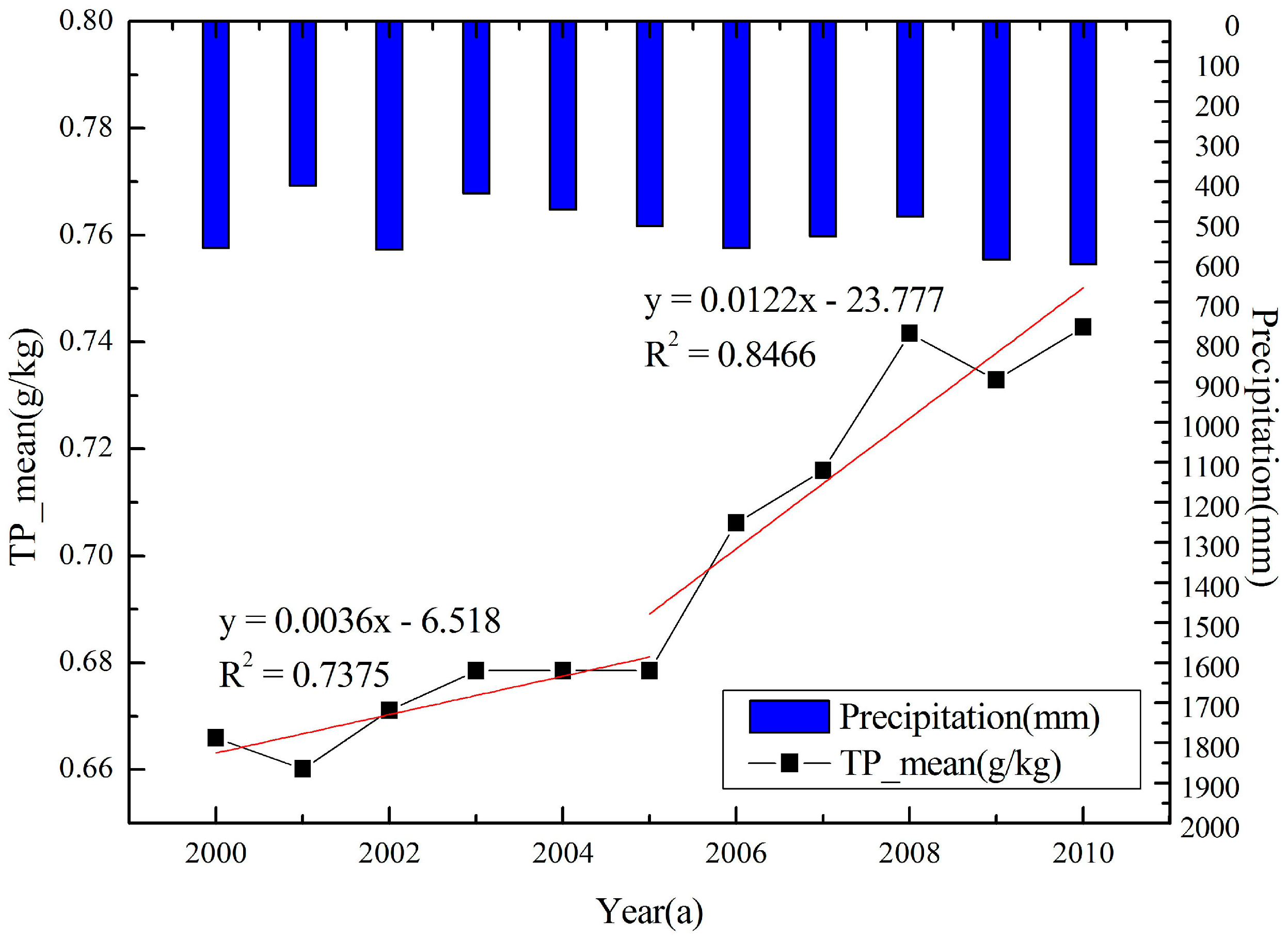
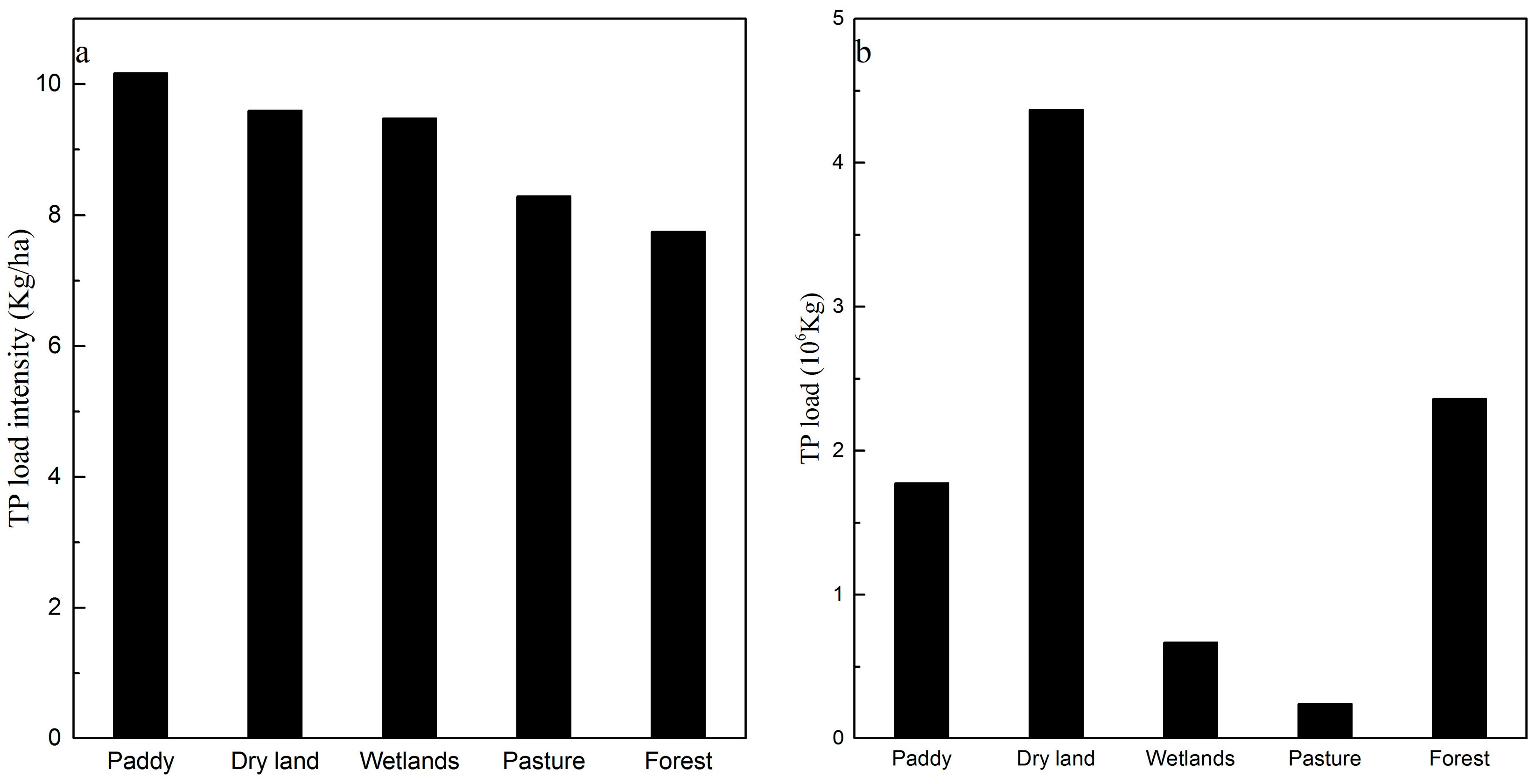
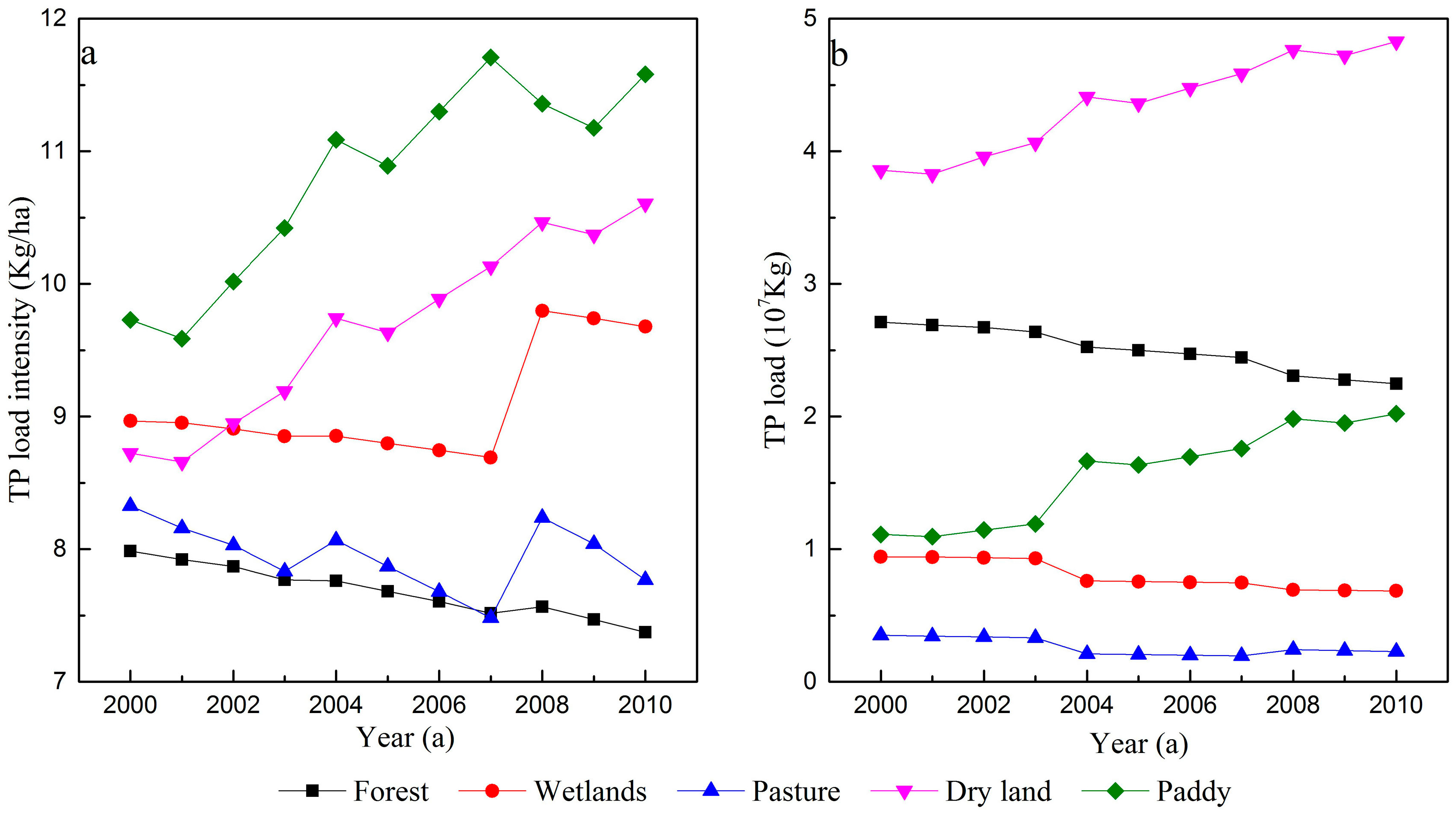
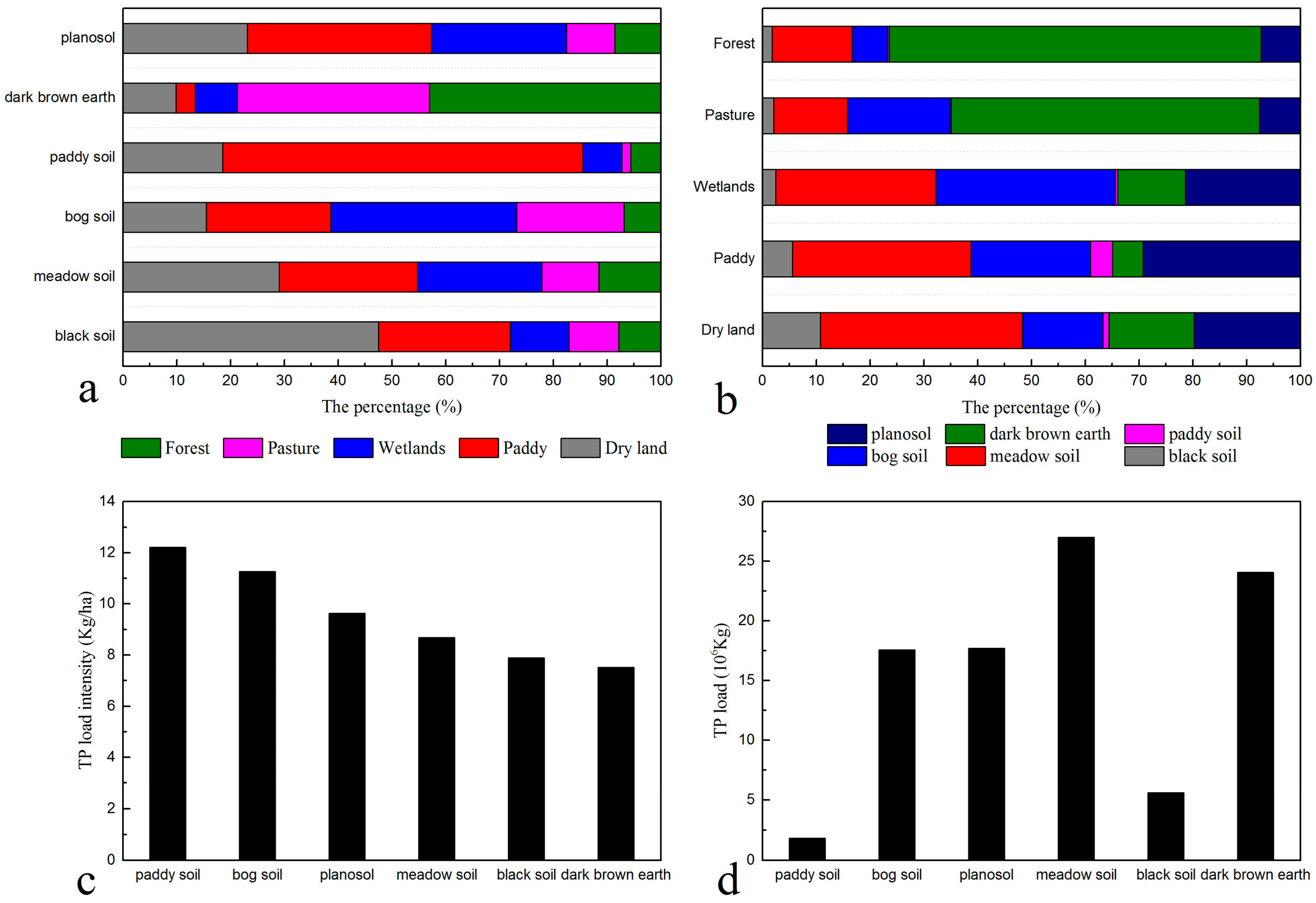

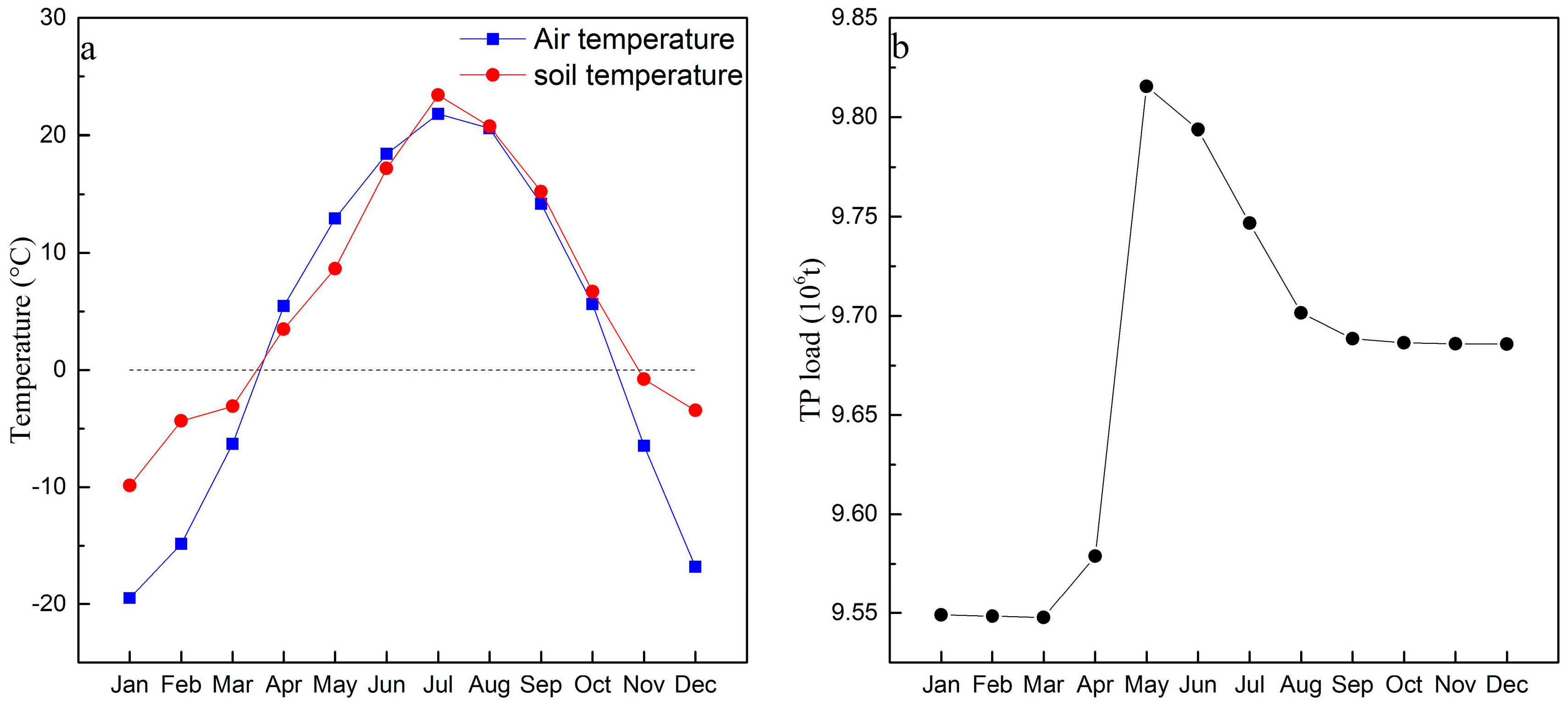
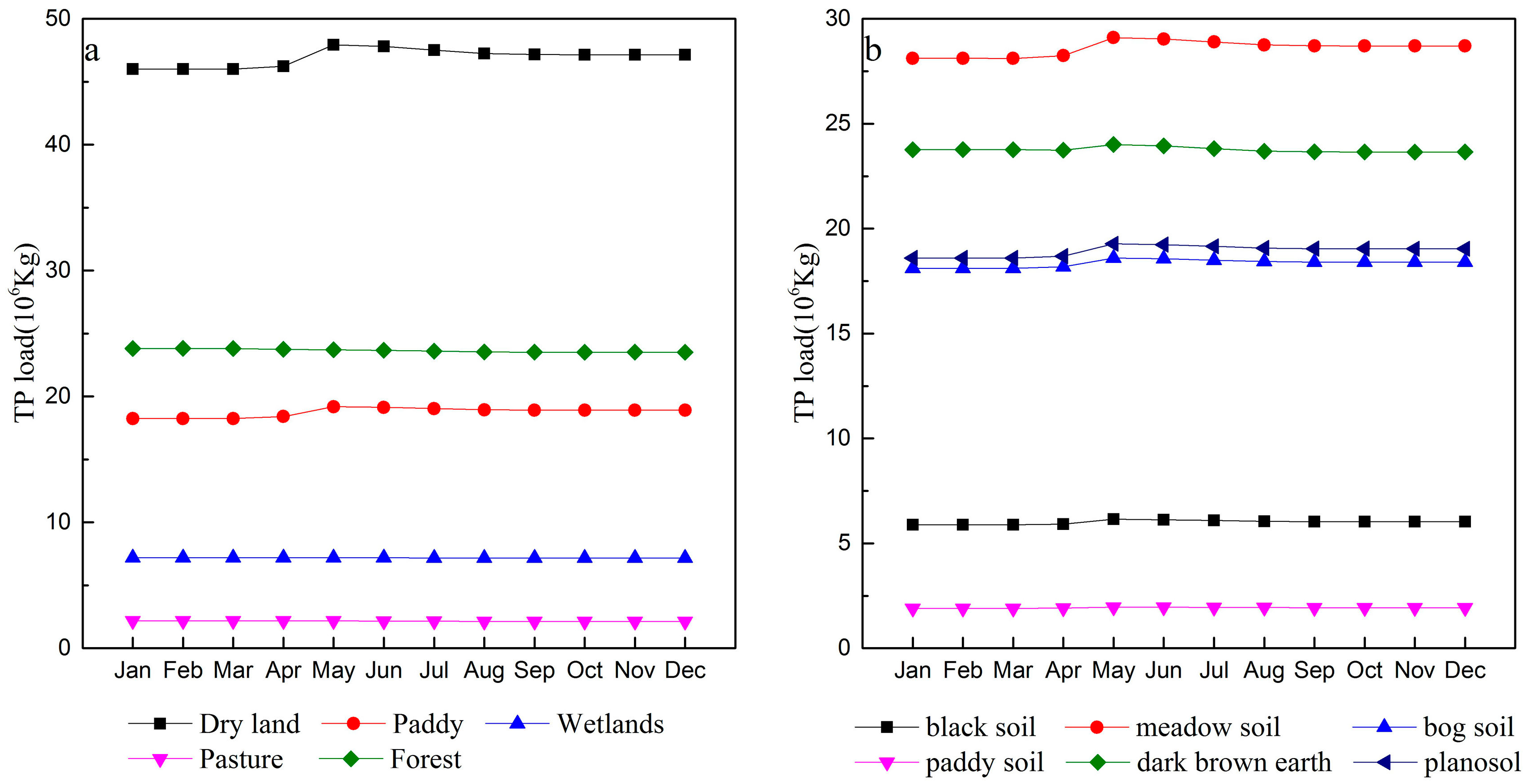
| Data Type | Scale | Data Description | Source |
|---|---|---|---|
| Digital Elevation Model | 1:250,000 | Elevation, overland and channel slopes and lengths | Institute of Geographical and Natural Resources Research, Chinese Academy of Sciences; National Geomatics Centre of China |
| Land Use | 1:100,000 | Land use classifications | Institute of Geographical and Natural Resources Research, Chinese Academy of Sciences |
| Soil Properties | 1:1,000,000 | Physical and chemical properties of soils | Institute of Soil Science, Chinese Academy of Sciences |
| Weather Data | - | Precipitation, daily maximum and minimum air temperature, relative humidity and solar radiation | China Meteorological Administration; Local Bureau of Meteorology |
| Hydrology and Water Quality | - | Local hydrographical station and environmental monitoring station | Social and economic data, population, livestock rearing, fertilizer application, field investigation; statistics yearbook |
| Land Use | Total Area (km2) | 2000–2005 | 2000–2010 | 2005–2010 | |||||
|---|---|---|---|---|---|---|---|---|---|
| 2000 | 2005 | 2010 | km2 | % | km2 | % | km2 | % | |
| Unutilized | 64 | 106 | 106 | 42 | 65.6 | 42 | 65.6 | 0 | 0 |
| Urban | 2246 | 2336 | 2499 | 90 | 4 | 253 | 11.3 | 163 | 7 |
| Dry land | 44,224 | 45,274 | 45,519 | 1050 | 2.4 | 1295 | 2.9 | 245 | 0.5 |
| Paddy field | 11,420 | 15,016 | 17,451 | 3596 | 31.5 | 6031 | 52.8 | 2435 | 16.2 |
| Wetlands | 10,504 | 8590 | 7075 | −1914 | −18.2 | −3429 | −32.6 | −1515 | −17.6 |
| Pasture | 4220 | 2616 | 2931 | −1604 | −38 | −1289 | −30.5 | 315 | 12 |
| Forest | 33,963 | 32,524 | 30,478 | −1439 | −4.2 | −3485 | −10.3 | −2046 | −6.3 |
| Water | 2183 | 2355 | 2758 | 172 | 7.9 | 575 | 26.3 | 403 | 17.1 |
| No. | Model Name | Equation | Reference | |
|---|---|---|---|---|
| 1 | NPP Simulation | CASA model [37] | ||
| 2 | Production Distribution | ForNBM model [38] | ||
| 3 | Nutrient Absorption | ForNBM model [38,39] | ||
| 4 | Vegetation Litter | ForNBM model [38] | ||
| 5 | Fertilization | SWAT model [40] | ||
| 6 | Mineralization & Decomposition. | Model [36] | ||
| 7 | Inorganic P Absorption | SWAT model [40] | ||
| Data Type | Samples | Mean Value (g/kg) | Min Value (g/kg) | Max Value (g/kg) | Standard Deviation | Standard-Error of Mean |
|---|---|---|---|---|---|---|
| Observed | 41 | 0.881 | 0.71 | 1.12 | 0.0972 | 0.0152 |
| Simulated | 41 | 0.8786 | 0.6483 | 1.0670 | 0.0902 | 0.0141 |
© 2016 by the authors; licensee MDPI, Basel, Switzerland. This article is an open access article distributed under the terms and conditions of the Creative Commons Attribution (CC-BY) license (http://creativecommons.org/licenses/by/4.0/).
Share and Cite
Wang, Z.; Yang, S.; Zhao, C.; Bai, J.; Lou, H.; Chen, K.; Wu, L.; Dong, G.; Zhou, Q. Assessment of Non-Point Source Total Phosphorus Pollution from Different Land Use and Soil Types in a Mid-High Latitude Region of China. Water 2016, 8, 505. https://doi.org/10.3390/w8110505
Wang Z, Yang S, Zhao C, Bai J, Lou H, Chen K, Wu L, Dong G, Zhou Q. Assessment of Non-Point Source Total Phosphorus Pollution from Different Land Use and Soil Types in a Mid-High Latitude Region of China. Water. 2016; 8(11):505. https://doi.org/10.3390/w8110505
Chicago/Turabian StyleWang, Zhiwei, Shengtian Yang, Changsen Zhao, Juan Bai, Hezhen Lou, Ke Chen, Linna Wu, Guotao Dong, and Qiuwen Zhou. 2016. "Assessment of Non-Point Source Total Phosphorus Pollution from Different Land Use and Soil Types in a Mid-High Latitude Region of China" Water 8, no. 11: 505. https://doi.org/10.3390/w8110505






